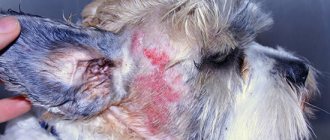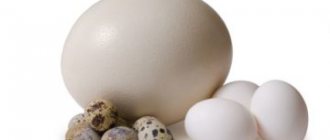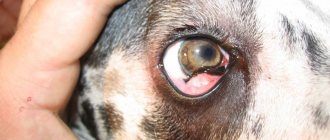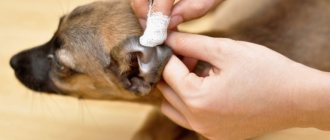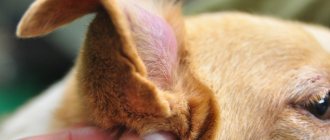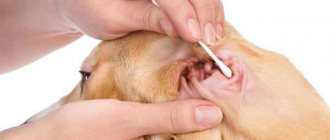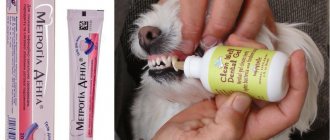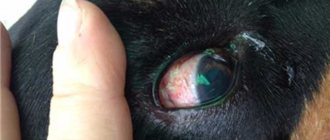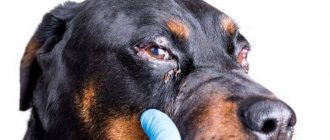Orchitis (epididymitis) is an inflammatory process that affects the male gonads - the testicles. Pathology can be either acute or chronic. There are many causes of the disease - from a banal mechanical injury to the scrotum to dropsy of the testicular membranes. In veterinary practice, the disease is more often diagnosed in adult animals that have crossed the 4-year mark.
The consequence of the pathology can be infertility, so it is important to make a timely diagnosis and begin effective treatment. Read more about the disease in this article.
Causes of the disease
The disease is characterized by acute and chronic forms.
The causes of orchitis can be:
- infections with a viral pathogen (plague, brucellosis, jaundice);
- infections of a bacterial nature (inflammation of the bladder - cystitis; inflammation of the prostate - prostatitis);
- damage to the scrotum area as a result of insect bites;
- inflammatory processes in the skin (dermatitis) in the testicular area;
- pathologies of the genital organs (for example, inguinal hernia, torsion of the spermatic cord);
- dropsy of the testicles (hydrocele);
- malignant tumors;
- autoimmune diseases.
Causes of testicular inflammation in dogs
In most cases, bacterial and viral local infections lead to the development of pathology.
Causes of testicular inflammation in dogs:
Based on the causes that provoke the disease, orchitis can be traumatic, infectious (bacterial), or systemic.
Orchitis in a male dog can occur against the background of mycoses, chlamydia, brucellosis, leptospirosis, canine distemper, other diseases of a viral-bacterial, parasitic nature that affect the entire body, as well as diseases that are accompanied by high fever.
Bites of blood-sucking insects in the scrotum area, for example, ticks, can also cause orchitis.
There is no breed or genetic predisposition to orchitis. At the same time, according to statistics, dogs prone to allergies, dermatitis, dermatoses, as well as large, giant breeds of dogs, as well as homeless street animals are at risk.
Urolithiasis disease
The disease is provoked by a high content of proteins in food and a lack of fluid. Experts note the dependence of the frequency of diseases on the breed and age of the animal. At risk are schnauzers, spaniels, Pekingese, Dalmatians, bulldogs, poodles and some others. Symptoms include swelling and redness of the genital organ, urinary retention for up to several days, lethargy, and bloody discharge from the urinary canal.
The disease is insidious and does not manifest itself immediately. The prognosis is not always favorable, especially in older dogs. Qualified assistance is of great importance.
Which breeds are more susceptible
There is a risk of disease in breeds susceptible to various types of dermatitis if the focus of skin inflammation is located in the area of the testes. Dogs of large and massive breeds (German and Dogues de Bordeaux, Mountain Dogs, Newfoundlands and others) are prone to dermatitis.
However, orchitis has an inflammatory or traumatic nature, so the possibility of illness in a dog of any breed cannot be excluded. All dog breeds are susceptible to orchitis, but most cases affect adults.
STD
The reason why the skin on the dog's testicles is red,
It often becomes an infection that the dog received during mating. The danger is that the incubation period can range from 2 to 8 months, although the dog is capable of infecting its partners during this entire time. The following diseases are transmitted during mating:
- Venereal sarcoma. The pathology, which occurs only in dogs, has all the properties of an oncological disease except the ability to metastasize. The localization site, the mucous membrane of the genital organs, resembles a bright red cauliflower. By licking, the dog transfers living tumor cells to other places, increasing the affected area. Dogs leading a free lifestyle are more often infected. Surgical treatment does not give positive results. In veterinary practice, 95-100% effectiveness has been achieved through the simultaneous use of radiation and chemotherapy.
- Gonococcal urethritis (gonorrhea). It manifests itself as swelling and redness of the genitals, painful urination. The method of treatment is determined by the doctor.
- Herpes .
The disease occurs secretly, but sometimes ulcerations and red spots can be seen on the genitals of male dogs. Treatment is carried out with antiviral veterinary drugs under the supervision of a specialist.
It is not possible to independently diagnose an STD in your pet; if you suspect something is wrong, you should immediately go to an appointment with a veterinarian. It is recommended to do the same before each mating, as a preventive measure.
Causes of the disease
Orchitis most often begins as a result of local infection of the testes due to injury or insect bites in the scrotum area. Viruses can end up in the dog’s testes when infected with distemper, or due to inflammatory processes occurring in organs in the immediate vicinity - for example, with prostatitis or cystitis.
The cause may be bacterial infection such as ehrlichiosis, transmitted by tick bites, as well as fungal mycoses (coccidioidomycosis and blastomycosis).
Dermatitis in the scrotum, groin hernia, spermatic cord torsion, granuloma (sperm-filled lump), hydrocele (edema of the testicular membranes) and tumors (neoplasia) are risk factors for developing this disease.
Leptospirosis or brucellosis are dangerous systemic infections that affect the entire body and can also lead to orchitis.
There is autoimmune orchitis, the essence of which is that after injuries or infectious diseases, the body, as a result of the work of the immune system, begins to perceive testicular tissue as foreign and reject it. The result is chronic inflammation of this organ. It is unlikely to cure this form of the disease, since it is difficult to make the immune system work differently.
Older animals that already have various diseases of the genitourinary tract are most susceptible to orchitis. The disease is often observed in younger male dogs that are walked outside freely or without proper supervision.
Main symptoms
Symptoms of a dangerous disease that occurs in acute form:
- swelling of the testes;
- pain when moving;
- the skin of the scrotum acquires a red-blue tint;
- swelling of the scrotum;
- the skin on the scrotum is irritated, the male constantly licks it, which contributes to the formation of wounds;
- drowsiness, immobility;
- refusal to eat;
- increased body temperature;
- restless behavior;
- difficulty urinating.
In the chronic form of the disease, the animal experiences:
- soreness;
- hardening of the testicles;
- increased temperature of the area;
- discomfort.
Symptoms
Inflammatory processes in the scrotum area are manifested by the following symptoms:
- the eggs will greatly increase in size, become edematous, swollen;
- the pet constantly licks the scrotum, which poses a danger when wounds and abrasions appear;
- the affected area is red, the skin is tense;
- increased organ temperature;
- when you touch the scrotum, the dog whines, barks, and may bite;
- decreased motor activity, change in gait.
Additional signs are weakness, depression, refusal to eat, fever, emaciation. The pet sleeps more often and hardly gets up. If the form of the disease is chronic, then infertility develops.
Traumatic orchitis
Orchitis(
Orchitis) - inflammation of the testis. It is found in farm and domestic animals of all types. One or both testes are affected, often with an appendage.
- Traumatic orchitis occurs due to a bruise or fall of an animal;
- Purulent orchitis - as a result of wounds of the testis, the transfer of the purulent process from the surrounding tissues;
- Infectious orchitis is observed in some infectious diseases (for example, brucellosis).
Clinical signs
In traumatic orchitis, the testis is enlarged, painful on palpation, dense, and has a smooth surface. The spermatic cord is often thickened; the scrotum is swollen and infiltrated, abrasions and bruises are found on its skin. The pelvic limb is set outward, its removal is difficult. The animal is depressed, appetite is reduced.
The general and local temperature is increased, the pulse and breathing are rapid, and attacks of colic are possible. With purulent orchitis - high body temperature, refusal to feed, a state of depression. Regional lymph nodes are enlarged and painful. Scrotal swelling extends to the prepuce and ventral abdominal wall.
The testis is greatly enlarged, painful, and later there may be areas of softening, fluctuations and fistulas.
Diagnostics in a veterinary clinic
To exclude the development of a dangerous disease and minimize the risk of infertility, it is necessary to consult a doctor without delay.
The veterinary clinic performs an external examination of the pet with palpation.
Tests ordered:
- urinalysis, urine culture;
- Ultrasound of the testes, testicular appendages and prostate gland;
- general blood analysis;
- blood chemistry;
- blood for brucellosis (to exclude a dangerous infectious disease);
- material from an open wound for the presence of bacteria;
- fluid from the testes;
- bacterial culture of the prostate;
- sperm (if the doctor decides).
With infectious orchitis, a blood test will show a large number of white blood cells; with cystitis or prostatitis, protein, blood, pus, and proteins are present in the urine.
If there are open wounds, the doctor will order a test for bacterial infections.
Based on the results of the examination, the doctor makes a diagnosis.
Treatment
See your doctor. To identify the cause of inflammation, blood and urine tests are prescribed. With infectious orchitis, the content of leukocytes in the blood increases. In the urine of cystitis or prostatitis, pus, blood, increased levels of leukocytes, and protein are detected. An ultrasound of the testicles is performed, and if wounds are found on the scrotum, an examination is performed for the presence of bacterial infections. In selected cases, a biopsy is performed.
Treatment depends on the condition and whether the animal is planned to be used for breeding. The best solution, especially for severe acute orchitis, is castration. After the operation, a course of antibiotics is given. In stud dogs, the affected testicle is removed. Often, with unilateral castration, the dog becomes infertile. Treatment with antibiotics without castration does not lead to complete recovery. In breeding animals, after a course of treatment, the viability of sperm is checked.
Animals, like people, have various health problems. Some of them are congenital, others indicate improper care, and some appear with age. Quite often, owners of male dogs over four years of age go to the veterinary clinic with a complaint that the dog’s eggs are swollen.
.
Causes of egg tumors in dogs
Orchitis
is a disease characterized by inflammation of the genital area in a dog.
Quite often, such inflammation is expressed in the fact that the dog has a swollen egg
. There are several reasons for this symptom:
- Injury to the scrotum caused by mechanical impact during a walk, fight, etc.
- An infectious or viral disease that affects the bladder and organs of the urinary system.
- Inguinal hernia.
- Insect bite, etc.
If you constantly monitor the health of your pet, then recognizing orchitis in a dog will not be difficult.
If the tumor
is not visible to the naked eye, then the owner should be wary of the behavior of his dog. Males with the development of orchitis constantly lick the sore spot. A superficial examination may reveal the presence of wounds from mechanical trauma or an insect bite.
It is painful for a dog with orchitis to sit, it is often painful to walk, and he may refuse to eat or walk. In addition, there is often a significant increase in body temperature during exacerbation of the disease.
Useful video
For information on the causes, symptoms and treatment of orchitis in dogs, watch this video:
Similar articles
- Pyoderma in dogs: types - superficial, deep... An unpleasant dermatological disease - pyoderma in dogs. Author of the article: Lyubov Ilyina (veterinarian). Purulent inflammation of the skin of domestic animals caused by pathogenic microorganisms (pyoderma)… Read more
- Cholecystitis in dogs: symptoms, acute and chronic...
Inflammation of the biliary tract or cholecystitis in dogs. ... Causes of the disease. The reasons leading to the development of inflammation in the bile ducts in four-legged friends include Read more - Inflammation of the salivary glands in a dog: symptoms, treatment
Causes of inflammation of the salivary glands in a dog. In dogs, according to their anatomical location, the parotid, submandibular, sublingual and zygomatic glands are distinguished. Read more - Salmonellosis in dogs: first symptoms, analysis...
Inflammation of bones and periosteal tissues or osteomyelitis in cats: what... Unexpectedly detected arthritis in cats is not a reason to panic, but... .serp-item__passage{color:#888}... We recommend reading about pneumonia in dogs. Read more - A dog has pus from the nose: symptoms of sinusitis, how to treat...
Symptoms of sinusitis in a dog and other diseases. An irritating agent (microorganisms, poisons, foreign body, allergen) causes swelling... Sinusitis in dogs is an inflammation involving the maxillary sinuses. Read more
Treatment method and prognosis
Depending on the diagnosis, the pet is prescribed treatment.
If the animal is in severe pain, analgesics are prescribed for pain relief.
Based on the results of determining the type and sensitivity of microflora, antibiotic therapy is prescribed. If necessary, antihistamines are added to relieve swelling.
Also, pain can be reduced by cooling ointments, which should be recommended by a doctor. Using ointments on your own can irritate the sensitive skin of the scrotum and lead to eczema.
During the treatment period, it is necessary to protect the scrotum with inflamed testes from accidental injury, as well as from the male licking the medicinal ointment. To do this, you can sew it yourself or buy a protective bag (suspensor) at the pharmacy.
In the early stages, orchitis can be treated quite safely.
In its advanced form, orchitis always inhibits the formation of sperm, which can lead to infertility in a male dog, despite a favorable outcome of treatment. In this case, at the end of treatment, it is recommended to take a fertility test.
A severe form of the disease, aggravated by damage to the entire body by an infectious pathogen, is often an indication for surgical intervention - castration of the pet.
In older male dogs, the chronic form of the disease is more common, which can develop into tumor changes. If over time the volume of the affected testis increases, then castration is definitely recommended.
Treatment and care for a sick dog
Treatment of a dog suffering from orchitis can have two options, depending on the nature of the disease.
If the dog is not used as a valuable breeder, it is recommended to immediately castrate it.
If it is desirable to preserve the function of reproduction of offspring, and only one testicle is affected by inflammation, the male dog undergoes partial castration, with the removal of only the diseased part of the organ. But such an operation may subsequently still not prevent the dog from developing infertility.
It is recommended to neuter your dog if you are diagnosed with orchitis.
After surgery, in both cases, antibiotic treatment is required for three weeks. If one testicle has been removed, at the end of this treatment period, an examination is carried out to determine the viability of sperm in the remaining organ.
In addition to the mandatory course of antibiotics, the doctor may prescribe:
- painkillers;
- cold compresses;
- corticosteroid drugs to more quickly relieve inflammation;
- intravenous drugs that relieve intoxication;
- medications to support heart function;
- antifungal, if concomitant fungal infections are detected;
- in the case of autoimmune orchitis - immunosuppressants, drugs that suppress the immune response, for example, prednisone.
Attempts to cure orchitis without castration, using antibiotics alone, very rarely give positive results. In many cases, this leads to the development of sepsis, peritonitis and the painful death of the dog.
Important! You cannot try to diagnose and treat yourself; you must visit a doctor and follow all his recommendations.
Testicular inflammation
In our country, many earn their living by breeding and selling purebred dogs. It is quite natural that in this case special attention is paid to the health of pets, since diseases can ruin a businessman. Orchitis in dogs is especially dangerous for breeders, since this pathology can put an end to the reproductive function of a stud dog.
Basic information
- Orchitis is an inflammatory disease of the testes (testes) that is quite common in dogs. It can be unilateral or bilateral, often accompanied by epididymitis, since the testis and its appendages are naturally closely connected to each other. What are the causes of this pathology?
- In dogs, orchitis is usually caused by a bacterial infection. Bacteria penetrate into the testes through sexual contact, diseases of the urinary system and kidneys, and injuries. Very often, orchitis is caused by canine distemper virus, mycosis (blastomycosis and coccidioidomycosis), and ehrlichiosis.
- It is important to remember that not only injuries with penetration of foreign objects into the scrotal cavity or the testicle itself are dangerous, but also its crushing. The fact is that in the latter case, orchitis may be in the nature of an autoimmune pathology. The disease can be acute or chronic. Free-ranging males are at greatest risk.
Also at risk are older animals with chronic urinary tract infections.
Dogs often exhibit different clinical signs, as they depend on the general condition of the animal, age and etiology of the disease.
Orchitis is inflammation of the testicle. It occurs as a complication of infectious diseases (influenza, tuberculosis, etc.), or with trauma to the scrotum.
The disease develops rapidly: the testicle increases in size, becomes dense, sharply painful, and the temperature rises. Anti-inflammatory therapy is carried out, bed rest is observed, and a jock strap is worn. After the inflammatory phenomena subside, you will need to wear a jockstrap and prohibit sexual activity until the doctor’s permission.
When inflammation of the testes continues for several days, warm, moist compresses can be used, but irritating ointments (ichthyol and camphor) should not be used for this disease, since they cause excessive irritation of the sensitive scrotum and lead to the appearance of oozing eczema.
It is recommended to apply a well-lined bag with cotton wool - a suspensor, in which the scrotum and testes should hang freely. The suspensorium creates protection for the testes from external irritants, and also makes it impossible to lick the ointment from the scrotum. Such bags of different sizes can be purchased at the pharmacy.
They are attached using four ribbons on the dog's back, and in order to prevent the ribbons from being pulled back, you can additionally connect them to the collar. During the treatment period, you need to provide the dog with more rest and less movement.
Orchitis in dogs is characterized by an inflammatory process in the testicle. All dog breeds are susceptible to the disease, including the Yorkshire Terrier. In most cases, adults are affected.
Orchitis in dogs
Orchitis (epididymitis) is an inflammation of the male gonads - the testes.
Orchitis most often occurs in adult animals over 4 years of age.
Orchitis in males can be either acute or chronic.
Causes of orchitis . Depending on the cause of orchitis, testicular inflammation in dogs is usually divided into:
- Traumatic. This type of orchitis occurs as a result of various traumatic injuries received by a male dog in the scrotum area (bruises, cuts, bites, squeezing, pinching, tears).
- Bacterial. With bacterial orchitis, pathogenic microflora from any inflamed genitourinary organ (kidney, urethra, bladder) penetrates the dog’s testicle, where it multiplies in its tissues, causing inflammation.
- Systemic diseases. Infectious diseases that affect the entire dog’s body cause damage to the testes (canine brucellosis, leptospirosis in dogs).
Symptoms . Acute orchitis manifests itself in a dog with general depression, with rare attacks of anxiety, body temperature rises, swelling and an increase in the size of the scrotum occurs. The skin of the scrotum may be red or have a bluish tint. When palpating the scrotal area, the veterinarian notes severe pain in one or both testicles. The male moves carefully and slowly, spreading his hind limbs wide when walking.
In rare cases, without proper treatment, inflammation of the testicles in dogs becomes purulent and can be complicated by an abscess and the formation of a fistula in the scrotum. In this case, thick, creamy pus is released from the scrotum, sometimes mixed with blood.
Chronic inflammation of the testes in dogs is rare, mainly when the inflammatory process worsens or when the connective tissue begins to grow in the testicles and the testes begin to increase in size and harden excessively.
Diagnosis . The diagnosis of orchitis is made by veterinary specialists at the clinic based on a medical history (trauma to the scrotal area, a fight with another dog, etc.), a clinical examination with palpation of the scrotum. Blood testing in a veterinary laboratory for infectious diseases (brucellosis, leptospirosis, etc.).
An abdominal ultrasound will reveal cystitis (cystitis in dogs), urethritis (urethritis in dogs), prostatitis (prostatitis in dogs) and other pathologies leading to the development of epididymitis in dogs.
Differential diagnosis . Veterinary specialists differentiate orchitis in dogs from neoplasms (cancer oncology) and infectious diseases (brucellosis, leptospirosis).
Treatment. Treatment of orchitis in dogs by veterinary specialists is carried out depending on the cause of inflammation of the testicles in dogs.
If the cause of orchitis in dogs is an infectious disease (brucellosis, leptospirosis), then dogs with leptospirosis are isolated and complex treatment is carried out, including etiotropic (specific) therapy - the use of hyperimmune anti-leptospirosis serum and pathogenetic therapy. Hyperimmune anti-leptospirosis serum is administered subcutaneously to sick dogs at a dose of 0.5 ml per 1 kg of body weight once a day for 2-3 days. The serum is especially effective if used at the very beginning of the disease. A course of antibiotic therapy is carried out with drugs of the penicillin group, which are effective against Leptospira of various serogroups (benzylpenicillin, bicillin-1, bicillin-3). Dose of bicillin preparations: 10-20 thousand. ED per 1 kg of animal weight 1 time every 3 days (2 times a week). To stop leptospiraemia, the course of antibiotic treatment should consist of 2 to 6 injections. The use of streptomycin in a dose of 10-15 thousand units per 1 kg of dog body weight 2 times a day for 5 days is considered effective.
If pathogenic microorganisms enter the testes of dogs from other genitourinary organs, then a course of antibiotic therapy is carried out with broad-spectrum antibiotics. Today, veterinary specialists most often use fluoroquinols (pefloxacin and ofloxacin), as well as the veterinary drug ofloxacinvet 10% at a dose of 5 ml per 10 kg of dog’s live weight, the drug is administered once a day. Among antibiotics, it is also recommended to take cephalosporins (cefepi, cefuroxime, etc.). The course of treatment with cephalosplorins is 7-10 days.
For traumatic orchitis, painkillers are prescribed (amidopyrine, analgin) and a lumbar novocaine blockade is performed.
If testicular swelling is accompanied by high body temperature, a course of antibiotics is prescribed.
In case of abscesses of the scrotum, it is opened, washed with antibacterial solutions, and if necessary, drainage is done to drain the inflammatory exudate. A course of antibiotic therapy is prescribed.
To prevent the development of complications, a sick dog is prescribed hepatoprotectors and probiotics.
In cases where the dog’s owners have not sought veterinary help for a long time and the inflammation of the testes has progressed, the male dog is castrated. Male castration is also carried out on old dogs and those that do not provide breeding value.
Prevention . In order to prevent orchitis in dogs, dog owners must vaccinate them against infectious diseases common in the region of residence, including leptospirosis (preparing pets for vaccination and types of vaccines).
To avoid injury to the scrotum during fights with other dogs, it is necessary to walk the male dog on a leash. If you receive injuries in the scrotum area, promptly seek veterinary help from a veterinary clinic.
What to do at home
During treatment, the animal must be kept at rest and physical activity excluded.
Treatment at home must be carried out according to doctor's prescriptions.
In addition to cooling ointments, if prescribed by a doctor, you can use warm, wet compresses at home.
Medicines should be stored depending on the instructions in the instructions. If stored in the refrigerator, the medication must be at room temperature before use. The drug should “heat up” naturally. Any artificial increase in temperature will cause destruction of the composition of the medicine.
Neoplasms
The most dangerous are tumor diseases of the genitals. If you notice a change in the color of the testicles, determine by touch whether a cyst or tumor is causing their redness. If you find a lump, be sure to show your four-legged friend to the doctor. After removal of a cyst or benign formation, the body will recover quickly. If oncology is diagnosed, long-term treatment will be required.
Prevention of pathologies of the dog’s genital organs can be considered:
- avoiding contact with street animals;
- selection for mating of a potentially healthy partner;
- easy disinfection of the pet’s mucous membranes and genitals after walks;
- visiting a veterinarian for a preventive examination.
The best prevention of any disease is a healthy diet and a healthy lifestyle.
Testicular cancer in dogs is an oncological disease characterized by the appearance of a pathological neoplasm in the testicles, which is formed from the cellular structures of the gonads of animals. According to statistics, tumors of the testes make up 15-25% of all cancers of our smaller brothers. In veterinary practice, this pathology occurs in males of various age groups, but most often a tumor of the testes is diagnosed in uncastrated males after six to eight years. The main danger is the development of metastases. Moreover, if you identify signs of cancer in time, contact a veterinarian and begin treatment, the prognosis in most cases is favorable.
Not much different from human cancer. The disease develops due to cellular mutations that occur at the DNA level. Irreversible changes occur in the cells, as a result of which they cease to perform their natural functions. Due to rapid division, the number of mutating cellular structures increases, and they form into separate groups - tumors and daughter formations (metastases).
Neoplasms have
a malignant and benign nature
. Benign ones do not penetrate beyond the tissues in which they develop, so the prognosis in most cases with timely treatment is favorable.
Important! Pathological neoplasms compress tissues, blood vessels, nerves, displace, replace, and destroy healthy cells, which leads to disruption of the functioning of the affected organ.
Like any disease, a testicular tumor in a dog develops under the influence of various unfavorable exo- and endogenous factors, among which are:
- hormonal imbalance;
- genetic predisposition;
- age-related changes;
- endocrine diseases (hypoganadism);
- chronic pathologies of the reproductive system organs (inflammation of the appendages);
- severe injuries to the peritoneum and scrotum.
Testicular cancer is most often diagnosed in cryptorchid males. With cryptorchidism
, which can be unilateral or bilateral, one or two testes do not descend into the scrotum, but remain in the abdominal or groin area. The disease is transmitted genetically.
Important! Various forms of cryptorchidism in dogs increase the risk of neoplasms in an undescended testicle by 15 times. In 30-35% of cases, testicular cancer is diagnosed in males with bilateral cryptorchidism, in which both testicles are located in the intra-abdominal cavity.
Testicular cancer in dogs often develops after cancer, since the disease is recurrent, and also against the background of some viral, bacterial diseases, and infections. Classification of testicular cancer
Pathological neoplasms in the testes have different histological structures and etiopathogenesis. There are germinogenic, which arise from the seminiferous epithelium, and non-germinogenic, which are formed from the stromal epithelium, cellular structures that produce hormones.
There are three main types of testicular cancer diagnosed in dogs:
- Leydig tumor
(leydigoma). They develop in the descended testicles of males from interstitial cellular structures. They do not reach large sizes. They produce androgens, which leads to the formation of a constant hormonal background, which provokes the formation of tumors. Leydigomas are benign tumors and do not metastasize. - Seminomas.
They are formed from the cellular structures of the spermatic epthelium in the undescended testicle. Reach significant sizes. They do not produce hormones. Most often noted in males after 9-11 years. Metastasizes rarely, mainly to regional lymph nodes. - Sertoliomas.
Neoplasms that are formed from Sertoli cells. Produce estrogens. Changes in hormonal levels suppress secondary sexual characteristics in males. - Androblastomas
. Characterized by metastasis to other internal organs. Produce estrogens.
It is worth noting that tumors in dogs are quite often formed by various types of cancer cells. For example, in practice there are tumors of the testis (leidigoma) and cancer of the appendages. The most common type of testicular cancer in animals is germ cell tumors.
Note!
Lack of nutrients, hypervitaminosis, and weakened immunity cause skin dermatitis, which is usually localized around the muzzle and in the folds of the body, for example, the genitals. The dog’s testes often become swollen and red due to severe poor health, which can also lead to infectious diseases or the development of pathologies of internal organs. The reaction of each animal to this is always individual; the genitourinary system is not so rarely affected.
When a male dog often licks his testicles, exhibits strange behavior, or loses weight, then you need to examine him - it is very likely that his scrotum is very inflamed. Self-treatment without a veterinarian's prescription is unlikely to be effective, but can even be harmful. The fact is that there are many different causes of swollen testes in dogs, which manifest themselves in almost the same way. What looks like a simple food allergy can turn out to be a severe systemic infection, which is very dangerous for unvaccinated animals.
Testicular cancer in dogs is an oncological disease characterized by the appearance of a pathological neoplasm in the testicles, which is formed from the cellular structures of the gonads of animals. According to statistics, tumors of the testes make up 15-25% of all cancers of our smaller brothers. In veterinary practice, this pathology occurs in males of various age groups, but most often a tumor of the testes is diagnosed in uncastrated males after six to eight years. The main danger is the development of metastases. Moreover, if you identify signs of cancer in time, contact a veterinarian and begin treatment, the prognosis in most cases is favorable.
Clinical manifestations
Regardless of the histological structure and type of tumor. Testicular cancer in males is characterized by a predominantly slow progression. At the beginning of the development of pathology, with a detailed visual examination and palpation, you can notice a small painless compaction in the affected testis, which gradually increases in size.
Important! Neoplasms develop in males in one or two testicles. When a tumor develops in one testicle, the second one atrophies.
Symptoms of testicular cancer in dogs and the intensity of manifestations of cancer depend on the location of the tumor, the type, structure of the tumor, age, and physiological characteristics of the animal’s body.
The initial symptoms of testicular cancer in animals resemble acute orchiepididymitis. As the disease progresses, the scrotum is asymmetrically enlarged and swollen. Further development is associated with the appearance of metastases.
General clinical picture:
- enlarged testicles;
- swelling of one or two testicles;
- change in urine color (blood, clots);
- painful urination, polyuria. defecation disorder;
- infertility;
- enlargement of regional lymph nodes (lymphadenopathy);
- sudden weight loss, cachexia;
- depression, decreased activity;
- increased thirst;
- pain on palpation of the peritoneum, abdominal distension;
- decreased sexual activity;
- swelling of the penis, mammary glands.
With sertoliomas in dogs, general depression and deterioration in the condition of the coat are noted. The fur becomes matte and brittle. Symmetrical hairless areas are noticeable on the sternum and hind legs. The skin of the scrotum is thickened. The mammary glands are enlarged.
When nerve endings are compressed, dogs experience pain in the back and croup. If the lymph nodes are affected, lymphostasis develops along the lymphatic pathways, and the limbs swell. When the intestines are compressed, the act of defecation is disrupted due to intestinal obstruction. Compression of the ureters leads to hydronephrosis.
In non-germinogenic forms of cancer, hormonal levels and behavior change. Males lose interest in females and may experience sexual attraction to males.
